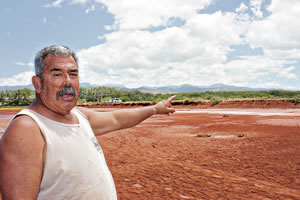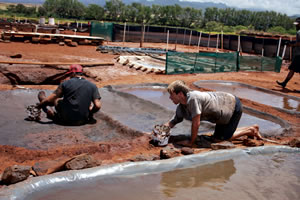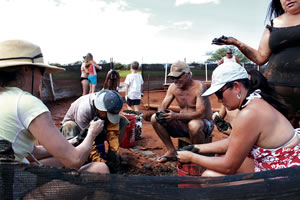Salt of the Earth

Frank Santos learned as a young boy from his kupuna how to collect salt from red clay ponds on the Westside, and now he and daughter Ku’uleialoha are passing along the wisdom of the ages to keep this cultural practice alive, and the salt still coming to share as gifts
Despite threats from pollution and modern life, a Westside ohana and friends carry on the ancient practice of collecting salt in clay ponds
It’s the first day of pa’akai season, and Frank Santos is just where he wants to be – at Salt Pond, alongside family, surrounded by glittering pans of what he says may as well be gold.
“There’s so much mana here,” Santos says. “It’s a blessing to be here. You’re working with the ‘aina, you’re in the sun, doing what your ancestors did. There’s a lot of value in that.”
Santos has been part of this ancient cultural practice at the salt patch, a few hundred feet from the sea at Salt Pond Beach in Hanapepe, for some 60 summers and counting. The patch is his home away from home, but also home to several lo’i, which are caked smooth with cool, dark clay and serve as beds for sparkling, prized salt.
It’s an honor to be part of this hustle and bustle, as not just anyone can come into the patch – you’ve got to be invited. A veteran of this experience, Santos seems to treat the day with as much delight as someone new to it, reveling in the company of younger generations who will continue to carry on the laborious and fruitful tradition in the future. Among them are his grandchildren, who arduously scrape, dig, rake and scoop with intermittent laughs, questions and plain old running around.
“This is how it was for me as a kid, and you’re working, but it’s really like you’re playing in the mud (clay), then you’re running to the ocean to swim and cool off, then you come back, eat lunch,” he says. “I mean, what childhood gets better than that?”Looking back, Santos says, “It was funny. The aunties, all wrapped up, wearing lauhaula hats, would say, ‘Boy, get me this, get me that, go do this, go do that, carry my salt,'” he says. “I was the youngest one.”
Working in the patch is hardly child’s play, and as Santos puts it, “everybody has a job,” as it’s impossible for one person to harvest pa’akai alone. But that’s kind of the point.
Proud of the technique he’s perfected over the years, which includes stirring the salt and agitating the water in a certain way, Santos explains his method.
“I’m here every day, checking the beds, moving the water,” he says. “It gets syrupy otherwise.”
Through a process that involves trial and error, Santos says, “You learn through mistakes. There were a lot of secrets passed on, but a lot of it is also learned by experience.”
Though interest in salt-making among youths has waned over the years – again, making salt is hard work – Santos says around six years ago younger people began to regain interest in what has once again been highlighted as part of the Westside’s legacy.
“There’s lots to learn, and I think people are becoming more aware of what they neglected,” Santos says. “People have rights to this place, and we’ve been trying to educate people to help preserve and protect it, because this salt is so precious.”Santos wants to do more than preserve the patch, however, especially since much of it has changed since he was a boy. Having grown up on the Westside, Santos has seen firsthand the ebb and flow of the former plantation-era area and the impact that population growth, industry and modernity has had on it.
“In the old days, we made more salt, we had more people,” Santos says. Not one to “grumble,” as he puts it, preserving the patch and the integrity of the pans which have to coexist with beachgoers and plantation, road and airport runoff (along with the vulnerability of being smack-dab in the middle of a recreation area) is no easy task. Just keeping the purity of the pans is a challenge when you’re contending with a slew of contaminants – broken bits of glass bottles, fish bones, road dirt, even sand – all of which have to be removed, he explains.
“We always were told, ‘Never make huhu, just cooperate so they never take this away from us,'” he says. “But at the same time, we have to stand up for it and make people aware of it.”
Frank’s daughter, Ku’uleialoha Santos, has come to be known by some as outspoken when it comes to preserving and protecting the patch.
“You would think that it would be easy to protect a piece of our culture that plays such a big part in our lives,” she says. “Think about it – the only place in the world that makes Hawaiian salt that isn’t sold, using the same practices from old still today.”
But, she says, in order to keep it going, it’s all about educating people. Ku’uleialoha says most of the problems come from a lack of knowledge – knowledge that even she didn’t always have.One example? The effect driving on the beach has on the patch.
“The sand close to the salt patch is starting to wash way – every time someone drives on the beach, they take the sand with them. This sand offers protection when the sea is high,” she says, adding that less beach means a greater potential for the patch to become flooded. “When I mention the whole sand thing, people tell me, ‘I seen you driving on the sand.’ Yes, I used to, but once I learned the damage it creates, I stopped. We tend not to think about how our actions affect our surroundings, but they do.”
While it’s nearly common knowledge that Mason jars or even small lauhala boxes of the salt are coveted as Kaua’i-only gifts (even dignitaries have brought them to other islands as omiyage), Ku’uleialoha points out that people don’t connect their actions with threatening the patch’s survival.
“Everyone loves pa’akai from Hanapepe,” she says. “It’s a gift when you receive it – it’s a gift that comes from one’s heart – it’s made with love for one’s culture and one’s family history. Yet it breaks my heart every time I need to prove how important it is to protect it.”
Calling her dad a “true local boy” who “loves big and gives the shirt off his back for his family and his community,” Ku’uleialoha, who started working in the salt patch when she was little, says as a teenager she didn’t “get” why her father loved it so much. It wasn’t until she got older and had children of her own that she realized how important it was “to teach our keiki to protect what we love.” Ku’uleialoha, who has two daughters, Pi’ilani Kali, a student at UHHilo majoring in Hawaiian studies, and Waileia Siale-Santos, 10, says she has since also learned “why it is important for my kids to be a part of it. No one in my house is allowed to miss a salt patch day. … Family is important: culture, history, preservation, protection, respect. And these are the morals that are taught in the salt patch.”
They’re also the kind of morals she hopes will encourage others to help keep the pans alive.
“Why not think of your home as bigger than the roof you live under?” she says. “Treat Hawaii as if it was under your roof.”
As far as preserving her salt-making legacy, Ku’uleialoha says she was disheartened when she learned Kaua’i’s ecosystem had made the list of top 10 places to visit before it dies.
“I love Kaua’i, I love everything about what makes this place unique, and yet we take it for granted as though it will be here forever. It won’t, unless we stand up and take pride in the place we call home.”
Her father agrees.
“When people come here and learn how hard it is to make salt, and that it isn’t something you can buy – it’s something given to you – it makes it all the more a gift,” Santos says. “That’s why I say it’s more valuable than gold. It’s a really a treasure.”







